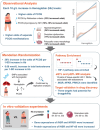Multiomics and Systematic Analyses Reveal the Roles of Hemoglobin and the HIF-1 Pathway in Polycystic Ovary Syndrome
- PMID: 39950870
- PMCID: PMC11984896
- DOI: 10.1002/advs.202411679
Multiomics and Systematic Analyses Reveal the Roles of Hemoglobin and the HIF-1 Pathway in Polycystic Ovary Syndrome
Abstract
Polycystic ovary syndrome (PCOS) affects reproductive and cardiometabolic health, yet its pathogenesis remains unclear. Emerging evidence links hemoglobin levels to metabolic disorders, suggesting a potential role in PCOS development. Here, we integrated a large-scale cohort study, Mendelian randomization (A genetic tool to infer causal relationships), bioinformatics analyses, and in vitro experiments to investigate the relationship between hemoglobin levels and PCOS. In a cohort of 20 602 women, each 10 g L-1 elevation in hemoglobin levels is associated with 22% higher odds of PCOS (adjusted odds ratio: 1.22, 95% confidence interval: 1.15-1.29, P < 0.001) and PCOS manifestations, particularly hyperandrogenism. Mendelian randomization analysis confirms that higher hemoglobin levels are associated with increased PCOS risk and elevated testosterone levels. The hypoxia-inducible factor 1 (HIF-1) pathway is enriched, identifying three testosterone-associated genes (nuclear factor kappa B (NFKB1), insulin receptor (INSR), protein kinase C alpha. Colocalization and druggability analysis supports shared genetic regions and confirmed these genes as druggable targets. Upregulation of NFKB1 and INSR are confirmed in both blood and ovarian granulosa cells of PCOS patients. The findings demonstrate that higher-end normal hemoglobin levels are associated with increased PCOS risk, potentially through a mechanism of elevating testosterone levels involving the HIF-1 pathway.
Keywords: causality; hemoglobin; hyperandrogenism; hypoxia‐inducible factor; polycystic ovary syndrome.
© 2025 The Author(s). Advanced Science published by Wiley‐VCH GmbH.
Conflict of interest statement
The authors declare no conflict of interest.
Figures




References
-
- Joham A. E., Norman R. J., Stener‐Victorin E., Legro R. S., Franks S., Moran L. J., Boyle J., Teede H. J., Lancet Diabetes Endocrinol. 2022, 10, 668. - PubMed
-
- Escobar‐Morreale H. F., Nat. Rev. Endocrinol. 2018, 14, 270. - PubMed
-
- Zhu S., Zhang B., Jiang X., Li Z., Zhao S., Cui L., Chen Z. J., Fertil. Steril. 2019, 111, 168. - PubMed
-
- van der Harst P., Zhang W., Leach I. M., Rendon A., Verweij N., Sehmi J., Paul D. S., Elling U., Allayee H., Li X., Radhakrishnan A., Tan S. T., Voss K., Weichenberger C. X., Albers C. A., Al‐Hussani A., Asselbergs F. W., Ciullo M., Danjou F., Dina C., Esko T., Evans D. M., Franke L., Gogele M., Hartiala J., Hersch M., Holm H., Hottenga J. J., Kanoni S., Kleber M. E., et al., Nature 2012, 492, 369. - PubMed
MeSH terms
Substances
Grants and funding
LinkOut - more resources
Full Text Sources
Medical
Miscellaneous
